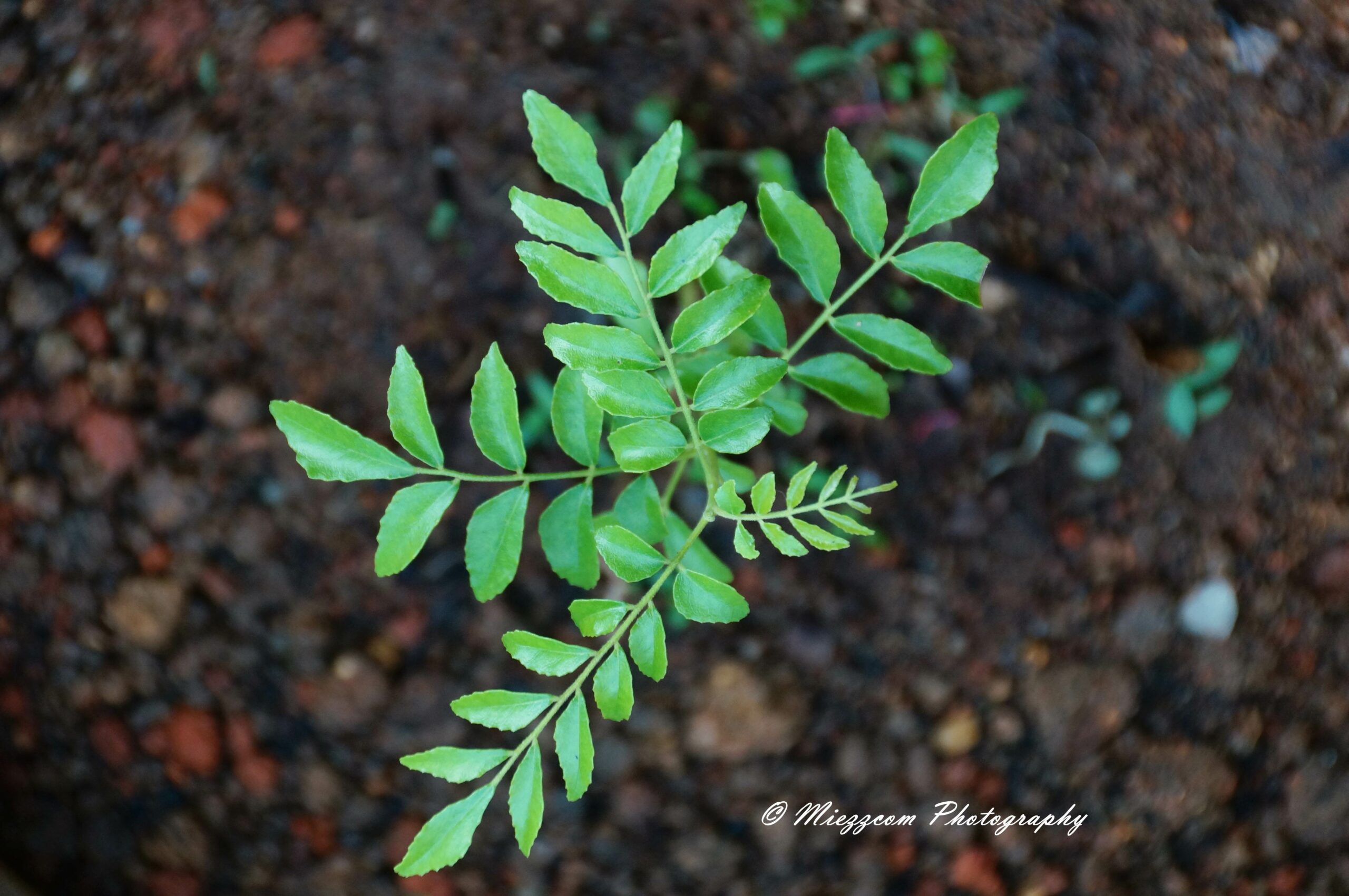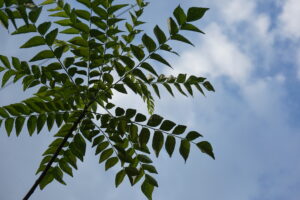Curry Leaves
Overview
Curry leaves, from the Murraya Koenigii plant, add a vibrant and unique flavor to South and Southeast Asian dishes with their aromatic foliage. These versatile leaves are not only kitchen favorites but also come with a bundle of health benefits. Despite their blessings to taste buds and well-being, curry leaves demand attentive care to thrive, fighting off common pests and diseases to grace your garden with their presence.

Characteristics
Known for its aromatic leaves, culinary significance in South Asian cuisines, and numerous health benefits.
Region
Native to India, the Curry Leaves plant is grown in South Asian and Southeast Asian regions.
Natural Habitat
Curry leaves plants are usually found in tropical and subtropical forests.
Cultivation
Prefers full sun to partial shade, consistent moisture without waterlogging, and well-drained, fertile soil with a neutral to slightly acidic pH.
Uses and Benefits
Curry leaves, brimming with vibrant flavor and aroma, have become an essential ingredient in many culinary traditions, particularly Indian cuisine.3 4 These small, glossy leaves not only add a distinctive taste to dishes but also offer a variety of potential health benefits.
Research suggests that curry leaves may support digestive health and possess antioxidant properties.3 Antioxidants are essential for combating harmful free radicals in the body, which can contribute to various health issues if left unchecked. By incorporating curry leaves into your diet, you may help support your body’s natural defenses.
In addition to their culinary and antioxidant properties, curry leaves have also gained recognition in traditional medicine for their potential benefits:
- Hair health: Curry leaves are believed to promote hair growth and improve overall hair health.3
- Blood sugar management: Some studies suggest that curry leaves may help maintain blood sugar levels within the normal range.3
While more research is needed to fully understand the extent of these benefits, incorporating curry leaves into your cooking is a simple and delicious way to potentially support your well-being. Whether you’re a seasoned chef or a curious home cook, experimenting with curry leaves can add an exciting new dimension to your culinary creations.

Cultivation Tips
Growing curry leaves at home can be a rewarding experience for nature-conscious gardeners. To ensure your Murraya koenigii thrives, choose a sunny spot that provides warmth and ample basking opportunities. Well-draining soil is crucial to prevent water retention, which can lead to root issues.
Regularly inspect your curry leaf plant for pests such as aphids. If detected, a simple solution of baking soda and water can be sprayed on the leaves to deter them5. To prevent leaf spot, take care to keep the leaves dry during watering and ensure proper air circulation around the plant.
While curry leaf plants can be somewhat temperamental and may not have an extended lifespan4, with attentive care and diligence, you can enjoy their aromatic leaves in your cooking for many years. As the plant matures under favorable conditions, it can develop from a shrub into a small tree with a woody trunk, adding a unique and attractive element to your garden.
To optimize growth and health, consider the following tips:
- Ensure the plant receives at least 6 hours of direct sunlight daily
- Water deeply but infrequently, allowing the soil to dry between watering sessions
- Fertilize monthly during the growing season with a balanced, organic fertilizer
- Prune regularly to maintain desired shape and size, and to encourage new growth
By following these guidelines, you’ll be well on your way to cultivating a thriving curry leaf plant and enjoying its flavorful leaves in your favorite dishes.
Seasonal Considerations
When growing curry leaves, it’s important to consider the seasonal changes and how they affect your plant. During the warm summer months, your curry leaf plant will thrive in a sunny spot outdoors, soaking up the rays and growing vigorously. However, as temperatures begin to drop in the autumn, it’s crucial to bring your plant indoors to protect it from the cold.
Once inside, place your curry leaf plant in a warm, bright location such as a south-facing window. If natural light is limited, consider using a grow light to provide the necessary illumination. Water your plant regularly, allowing the soil to dry slightly between watering sessions to prevent root rot.
As winter sets in, your curry leaf plant may experience slower growth or even drop some leaves due to the reduced light and cooler temperatures. Don’t be alarmed – this is a normal response to the seasonal change. Continue to care for your plant by providing adequate light, moisture, and occasional feeding with a balanced, water-soluble fertilizer.
With the arrival of spring, your curry leaf plant will begin to awaken from its winter dormancy. Gradually reintroduce it to outdoor conditions by placing it in a shaded area for a few hours each day, slowly increasing its exposure to direct sunlight over the course of a week or two. Once the risk of frost has passed, your plant can remain outdoors, enjoying the warm weather and bright sunshine once again.
By understanding and adapting to the seasonal needs of your curry leaf plant, you can help it thrive year-round, ensuring a steady supply of aromatic leaves for your culinary creations.

Issues and Troubleshooting
Curry leaves, while aromatic and beneficial, can encounter several issues. A common one is leaf spot; marks on leaves that indicate pests or disease. This condition often arises from unwelcome guests like aphids, which bring with them bacteria or fungi.5 Don’t panic, though! A simple spray made from a mix of baking soda and water in a 1:10 ratio can work wonders in controlling this problem.5
If your curry leaf plant is looking a bit lackluster despite your best efforts, it might be due to a few other factors:
- Overwatering: Ensure the soil is well-draining and allow it to dry out between watering sessions. Soggy roots can lead to fungal issues.
- Insufficient light: Curry leaf plants thrive in bright, indirect sunlight. If yours isn’t getting enough, consider moving it to a sunnier spot or using grow lights.
- Nutrient deficiencies: Feed your plant with a balanced, organic fertilizer every few weeks during the growing season to keep it nourished.
It’s also worth noting that these plants can be a tad finicky to care for. With some dedication to their wellbeing, you’ll keep your curry leaves happy and thriving. Remember, healthy plants are less prone to diseases and will reward you with their unique flavors and benefits for a longer time.
History and Folklore
Curry leaves, native to the lush subtropical and tropical regions of India, have a rich history interwoven with captivating folklore. This prized herb, known scientifically as Murraya koenigii, has been an integral part of South Asian culinary traditions for centuries. The plant’s name pays tribute to the renowned botanist Johann König, who extensively studied the flora of this region.
Beyond their culinary significance, curry leaves have long been revered in ancient Ayurvedic medicine. They are believed to symbolize good health and longevity, with their aromatic essence and medicinal properties celebrated for generations. The leaves’ importance is further emphasized in Hindu mythology, where legends suggest that they were created from the drops of amrit, the divine elixir of life1.
As one delves deeper into the history of curry leaves, it becomes evident that they are more than mere ingredients in a dish. They are cherished snippets of tradition, carrying stories and wisdom passed down through generations. The presence of curry leaves in kitchens across South Asia is not just a testament to their unique flavor, but also a reflection of the region’s rich cultural heritage.
From ancient tales to modern-day culinary delights, the curry leaf has stood the test of time. Its journey from sacred herb to beloved staple is a fascinating chapter in the annals of Indian history, forever linking the past with the present through its enduring aroma and flavor.
References
1. Own Yard Life. (2024). “Growing and Caring for Curry Leaf Tree – Own Yard Life.” https://ownyardlife.com/growing-and-caring-for-curry-leaf-tree/
2. IMARC Group. (2024). “Curry Leaf Powder Manufacturing Plant Project Report 2024: Industry Trends, Plant Setup, Machinery, Raw Materials, Investment Opportunities, Cost and Revenue.” https://www.imarcgroup.com/curry-leaf-powder-manufacturing-plant-project-report
3. Fire Pit Mag. (2024). “Curry leaves plant complete growing guide 2024.” https://firepitmag.com/garden/curry-leaves-plant-complete-growing-guide/
4. Curry Leaf Plant. (n.d.). “Curry Leaf Plant Care: The Ultimate Guide.” https://curryleafplant.com/blogs/how-to-grow-curry-leaf-plants/curry-leaf-plant-care-the-ultimate-guide
5. Morning Chores. (n.d.). “Growing Curry Leaf: Varieties, Growing Guide, Care – MorningChores.” https://morningchores.com/growing-curry-leaf/
Nicolas Duval
Nicolas is a passionate advocate for nature and the art of wildcrafting. His dedication shines through in Wildcraftia, a website he meticulously crafted to serve as a haven for nature enthusiasts worldwide. Driven by a deep appreciation for nature’s connection to humanity, Nicolas embarked on his journey in 2011 with SmokableHerbs, a platform showcasing his love for nature’s bounty. Building upon this foundation, he established Smokably, a thriving online store offering premium herbs and blends to a global audience.
